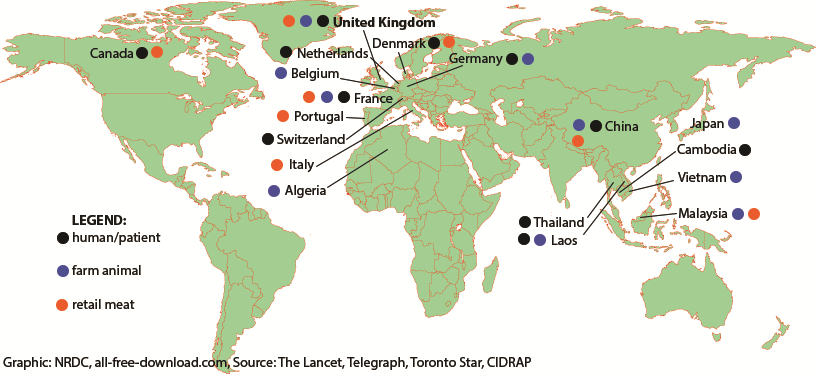Drug-Resistant Superbug Gene Found In At Least 19 Countries Since November Image courtesy of A map showing the countries in which the MCR-1 gene has been confirmed.
The gene (MCR-1) was first noted in a Chinese researchers for a Nov. 2015 report in The Lancet.
“The emergence of MCR-1 heralds the breach of the last group of antibiotics,” concludes the report, which at the time stated the belief that the gene is “currently confined to China.”
However, the Natural Resources Defense Council notes that in the months since the Chinese study was published, scientists have found the MCR-1 gene in countries all over the globe.
Some of the positive samples predate the Lancet report, so the gene has been spreading around the world for years.
As you can see from the map above, not only has the colistin resistance gene been found in Asia, Europe, Africa, and North America, it’s been identified in everything from farm animals to retail meat products to human patients. There are also unconfirmed claims of the gene showing up in South America.
The gene can be passed from bacteria to bacteria, and while it’s primarily been found in E. coli cells, it can also carry its colistin resistance over to other pathogens.
“Bacteria can collect resistance genes and splice them together on strands of DNA that can move around between bacteria,” explains the NRDC’s Carmen Cardova. “When a bacterium acquires one of these pieces of mobile DNA with many resistance genes, it can transform bacterium from one posing little threat to a potentially lethal superbug that resists treatment by multiple antibiotics.”
Interestingly, the FDA has tested nearly 3,000 of its salmonella samples for MCR-1, but the NRDC notes that the agency has only tested 76 of its thousands of available E. coli samples. So far, none of the tests have turned up the gene.
Perhaps the absence, at least so far, of the colistin-resistant gene in the U.S. has to do with the fact that colistin is not used on domestic livestock. However, the drug is used — for non-therapeutic reasons — on farm animals elsewhere in the world.
As noted in a recent report commissioned by UK Prime Minister David Cameron, the use of antibiotics in livestock on a worldwide level is expected to grow significantly as some of the world’s largest countries — Brazil, Russia, India, China, among them — seek to meet the increased food demands of a new middle class. The use of antibiotics in farming is expected to increase by 99% in these countries over the next fifteen years.
According to the Centers for Disease Control and Prevention, drug-resistant bacteria sicken two million Americans every year, killing more than 20,000. Drugs like colistin are used to treat those illnesses when other antibiotics are rendered useless.
Some argue that newer drugs are the answer, while others contend that fancier pills is just a way to kick the can down the road and that the only way to combat superbugs in the long run is to end the non-medical overuse of antibiotics in farm animals.
Want more consumer news? Visit our parent organization, Consumer Reports, for the latest on scams, recalls, and other consumer issues.


